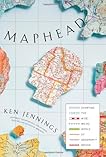 Maphead: Charting the Wide, Weird World of Geography Wonks
Maphead: Charting the Wide, Weird World of Geography Wonksby Ken Jennings
My rating: 4 of 5 stars
(actually more like 3.5 stars, but GoodReads doesn't allow half star ratings)
A quick read, similar in format and informality to Ken's inaugural Brainiac: Adventures in the Curious, Competitive, Compulsive World of Trivia Buffs book. All twelve chapter titles included a cartographic definition together with a quote. For example, the first chapter entitled 'Eccentricity' with the definition 'the deformation of an elliptical map projection' and the Pat Conroy quote 'My wound is geography.'
My favorite chapter falls in the center, halfway from nowhere to somewhere, Chapter 6 'Legend' with a definition of 'an explanatory list of the symbols on a map' and the C.S. Lewis quote 'Most of us, I suppose, have a secret country, but for most of us it is only an imaginary country.' I did a double-take when I read on p. 113 that Brandon Sanderson and Ken Jennings were college roommates. I heartily agree with Brandon's assertion that 'The hallmark of epic fantasy is immersion' and that's why he always includes maps in his books. Brandon goes on to relate to Ken that he 'started to look and make sure a book had a map. That was one of the measures of whether it was going to be a good book or not." When Brandon first read The Lord of the Rings he thought, 'Oho, he [Tolkien] knows what he's doing. A map and an appendix!' Ken states a few paragraphs later that 'Fantasy readers like that abrupt drop into the deep end and the learning curve it takes to keep up' further affirmed by Brandon's confirmation that 'By the end of a big epic fantasy novel, you'll have to become an expert in this world that doesn't exist. It's challenging.'
 |
| Pauline Baynes' map poster of Middle-earth published in 1970 by George Allen & Unwin and Ballantine Books. |
In Chapter 9 'Transit' (definition: 'a piece of surveying equipment used by mapmakers: a theodolite with a reversible telescope'), Ken sparked my interest in road rallies (something I always wanted to do when my husband was a member of the local SCCA). I always excelled at those trick-question instruction test in school, so I might just try Jim Sinclair's annual St. Valentine's Day Massacre (a contest by mail where you travel a circuitous course across American from the Golden Gate Bridge to the Statue of Liberty entirely by maps) next year. That is if I can find a way to sign up; an Internet search came up oddly sparse.
Ken introduced me to 'geocaching' in Chapter 10 'Overedge' (definition: 'the portion of the map that lies outside the neatline border'), which so intrigue me that I grabbed my Nook Color and signed up at Geocaching.com, even though I don't even own a GPS unit (outside of the one in my dumbphone which doesn't have any 'free' software associated with it to assist in finding or placing geocaches).
Overall, I enjoyed the few hours I spent geeking over cartography and geography with Ken Jennings as my tour guide. I learned a few things and I laughed out loud a couple of times. I can't think of a better way to spend a weekend, especially if cold November rain greets you on the other side of the door.
View all my reviews
No comments:
Post a Comment